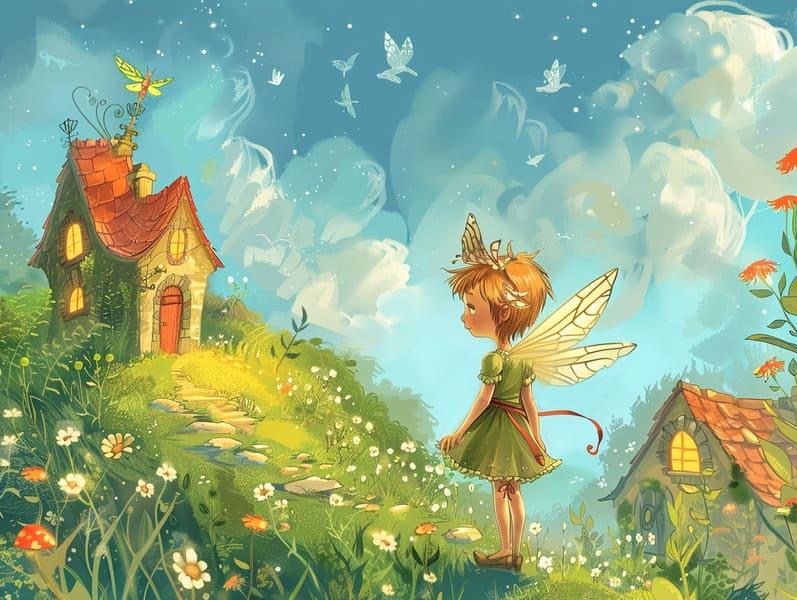
Best fairy tales have legendary status. These stories have been told from one generation to the next millennia before they were ever published. They originated from a variety of backgrounds, including Middle Eastern traditions. They were initially transmitted among elders, often carrying themes and messages relevant to the societal norms and beliefs of the time.
The Brothers Grimm, Jacob and Wilhelm (the Grimm brothers), were among the first to compile and publish many of these beloved fairy tales. Their compilation, "Grimm's Story Collection," included tales like "The Story of Cinderella," "Hansel and Grethel," and "The True Story of Snow White," which have since become classics in the world of children's fairy tales. Similarly, the Danish author's charming stories, such as "The Sea Maid," and "The Duckling that Could," have captivated hearts worldwide, solidifying their place in the pantheon of treasured fairy tales.
Despite their ancient origins, classic fairy tales remain as meaningful as ever, especially as nighttime stories for kids. These charming stories are now available in diverse formats, including gorgeously illustrated books, delightful animations, and internet fairy tales.
Their ongoing significance can be attributed to several magical reasons:
Crucial Morals: Ancient fairy tales often offer important moral lessons. Stories like "The Story of the Boy Who Cried Wolf" teach the value of sincerity, while "The Race of the Tortoise and the Hare" point out the virtues of resolve and modesty. These narratives offer young readers clear distinctions between moral and immoral, molding their moral compass in a subtle yet important way.
Compassion and Insight: Traditional fairy tales frequently include heroes facing difficulties and adversities, encouraging kids to relate with their struggles and back their triumphs. For instance, "Beauty and Her Beast" points out the virtue of seeing inner beauty to recognize the real person of a soul, fostering compassion and awareness.
Cultural Knowledge: Many fairy tales are interwoven with the cultural contexts from which they blossomed. Exploring these tales can provide intriguing perspectives into different ways of life, cultivating a sense of cultural insight and perception.
Inventiveness and Fantasy: The fantasy-filled elements in ancient fairy tales—supernatural elements—stimulate children’s creative dreams. These stories move readers to otherworldly realms, provoking fantasy-filled thoughts and a sense of excitement that persists a lifetime.
Ancient fairy tales are not only magical but also edifying. They serve as spellbinding tools in nurturing various cognitive and emotional skills in little ones. When old fairy tales are narrated, they cultivate language skills by teaching new language items and complex sentence structures. This practice also nurtures hearing perception and mental focus, as the young track the narrative, expectant to see what happens next.
Furthermore, deliberating the themes and characters of old fairy tales can cultivate cognitive skills and problem-solving abilities. Young ones are instructed to recognize patterns, predict happenings, and comprehend cause and effect. These contemplations also further little ones reveal their thoughts and feelings, fostering their emotional intelligence.
In today’s technological age, the availability of online fairy tales has made these stories more acquirable than ever. Online resources and mobile apps make available huge assortments of classic fairy tales that can be enjoyed or listened on anytime, anywhere. Fairy tales voiced are particularly popular, making available an enjoyable way for the young to experience these charming stories. Voice books and narrated videos take characters and settings to life, often complemented by fantastical soundtracks and musical scores that enhance the story adventure.
The lasting appeal of ancient fairy tales lies in their ability to adjust to new eras while preserving their core messages. Contemporary versions of these stories often showcase more inclusive figures and modern settings, making them pertinent to today’s audience. However, the basic principles of fearlessness, generosity, and impartiality remain unchanged, continuing to influence children of all ages.
Traditional fairy tales also offer a sense of comfort and recognition. They grant a tidy narrative with a plain beginning, middle, and end, often ending with the closure of conflicts and the triumph of righteousness over wickedness. This reliability can be consoling for kids, bringing a sense of sturdiness in an always shifting world.
Old fairy tales continue to fascinate and edify new generations, maintaining their splendor and importance in modern society. As kids' bedtime tales, they disclose a perfect blend of delight and instruction, advancing moral values, empathy, and creativity. The abundance of awesome site online fairy tales and the likability of fairy tales told out loud validate that these old narratives remain acquirable to new generations.
By safeguarding and making known these stories, we continue to treasure the rich tapestry of lore and cultural heritage. Whether you are reading a artistically illustrated book, viewing a digital library, or playing an read-aloud book, the grandeur of children's fairy tales is always within reach. These stories demonstrate of the undying presence of storytelling and its ability to gather us across time and space.
Be it you are discovering a artistically illustrated book, perusing a web-based library, or hearing an voice book, the beauty of popular fairy tales is always within reach.
These stories remind us of the consistent power of storytelling and its ability to bring us together across epochs and places, creating a bond that captivates and teaches alike.